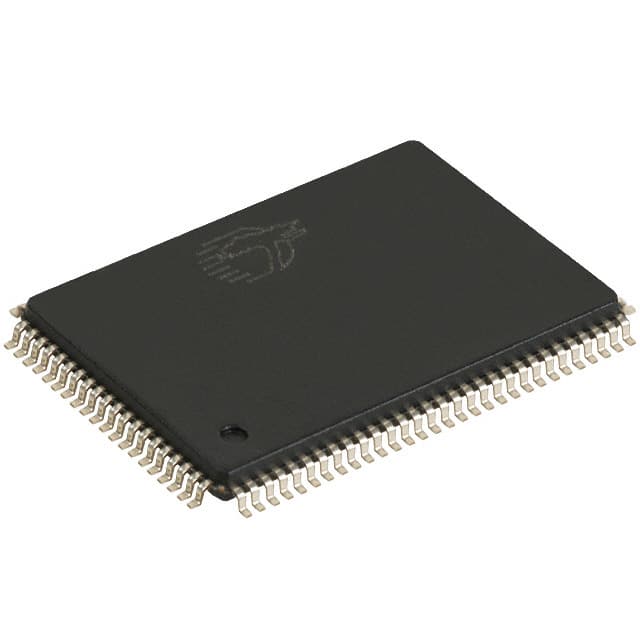CY7C1363C-133AXC
Product Overview
Category
The CY7C1363C-133AXC belongs to the category of integrated circuits (ICs).
Use
It is primarily used in electronic devices for data storage and retrieval purposes.
Characteristics
- High-speed performance
- Low power consumption
- Compact size
- Reliable operation
Package
The CY7C1363C-133AXC is available in a small outline integrated circuit (SOIC) package.
Essence
This product is an advanced memory chip that enables efficient data storage and retrieval in electronic devices.
Packaging/Quantity
The CY7C1363C-133AXC is typically packaged in reels or tubes, with a quantity of 250 units per reel/tube.
Specifications
- Memory Type: Synchronous Static Random Access Memory (SRAM)
- Organization: 1M x 36 bits
- Operating Voltage: 3.3V
- Speed: 133MHz
- Access Time: 6 ns
- Interface: Parallel
- Operating Temperature Range: -40°C to +85°C
- Pin Count: 100 pins
Detailed Pin Configuration
The CY7C1363C-133AXC has a total of 100 pins, each serving a specific function. The pin configuration is as follows:
(Pin Number) - (Pin Name) - (Function)
1 - VDDQ - Power Supply (+3.3V) 2 - DQ0 - Data Input/Output Bit 0 3 - DQ1 - Data Input/Output Bit 1 4 - DQ2 - Data Input/Output Bit 2 5 - DQ3 - Data Input/Output Bit 3 ... 100 - VSSQ - Ground
Functional Features
- High-speed data transfer
- Low power consumption
- Easy integration into existing electronic systems
- Reliable operation in various environmental conditions
Advantages and Disadvantages
Advantages
- High-speed performance allows for quick data access
- Low power consumption helps conserve energy
- Compact size enables space-efficient designs
- Reliable operation ensures data integrity
Disadvantages
- Limited storage capacity compared to other memory technologies
- Higher cost per unit compared to some alternative memory solutions
Working Principles
The CY7C1363C-133AXC operates based on the principles of synchronous static random access memory (SRAM). It stores data in a volatile manner, meaning that the stored information is lost when power is removed. The chip utilizes an internal clock signal to synchronize data transfers and ensure reliable operation.
Detailed Application Field Plans
The CY7C1363C-133AXC finds applications in various electronic devices that require high-speed data storage and retrieval. Some potential application fields include:
- Networking equipment: Used in routers, switches, and network servers to store routing tables and buffer data packets.
- Telecommunications systems: Employed in base stations, communication switches, and voice/data routers for efficient data handling.
- Industrial automation: Integrated into control systems and programmable logic controllers (PLCs) to store critical process data.
- Medical devices: Utilized in medical imaging equipment, patient monitoring systems, and diagnostic instruments for fast data processing.
- Automotive electronics: Incorporated into advanced driver assistance systems (ADAS), infotainment systems, and engine control units (ECUs) for reliable data storage.
Detailed and Complete Alternative Models
- CY7C1363B-133AXC: Similar to CY7C1363C-133AXC but with a different pin configuration.
- CY7C1363D-133AXC: Offers higher speed and improved performance compared to CY7C1363C-133AXC.
- CY7C1364C-133AXC: Provides increased storage capacity while maintaining similar characteristics to CY7C1363C-133AXC.
These alternative models offer different pin configurations, improved performance, and increased storage capacity, catering to diverse application requirements.
In conclusion, the CY7C1363C-133AXC is a high-speed synchronous SRAM chip that offers reliable data storage and retrieval capabilities. Its compact size, low power consumption, and compatibility with various electronic systems make it a versatile choice for numerous applications in networking, telecommunications, industrial automation, medical devices, and automotive electronics.
Lista 10 Vanliga frågor och svar relaterade till tillämpningen av CY7C1363C-133AXC i tekniska lösningar
Sure! Here are 10 common questions and answers related to the application of CY7C1363C-133AXC in technical solutions:
Question: What is the maximum operating frequency of CY7C1363C-133AXC?
Answer: The maximum operating frequency of CY7C1363C-133AXC is 133 MHz.Question: What is the voltage supply range for CY7C1363C-133AXC?
Answer: The voltage supply range for CY7C1363C-133AXC is 3.3V ± 0.3V.Question: Can CY7C1363C-133AXC be used in industrial applications?
Answer: Yes, CY7C1363C-133AXC is suitable for industrial applications due to its robust design and wide temperature range.Question: Does CY7C1363C-133AXC support multiple memory banks?
Answer: No, CY7C1363C-133AXC does not support multiple memory banks. It is a single bank device.Question: What is the maximum capacity of CY7C1363C-133AXC?
Answer: CY7C1363C-133AXC has a maximum capacity of 64 Megabits (Mb).Question: Is CY7C1363C-133AXC compatible with other memory devices?
Answer: Yes, CY7C1363C-133AXC is compatible with other SDRAM devices that adhere to the same specifications.Question: Can CY7C1363C-133AXC operate at different clock frequencies?
Answer: Yes, CY7C1363C-133AXC can operate at different clock frequencies within its specified range.Question: Does CY7C1363C-133AXC support burst mode operation?
Answer: Yes, CY7C1363C-133AXC supports burst mode operation for efficient data transfer.Question: What is the typical access time of CY7C1363C-133AXC?
Answer: The typical access time of CY7C1363C-133AXC is 5.4 ns.Question: Can CY7C1363C-133AXC be used in low-power applications?
Answer: Yes, CY7C1363C-133AXC has a low-power standby mode and can be used in low-power applications to conserve energy.
Please note that these answers are based on general information about CY7C1363C-133AXC and may vary depending on specific application requirements.


